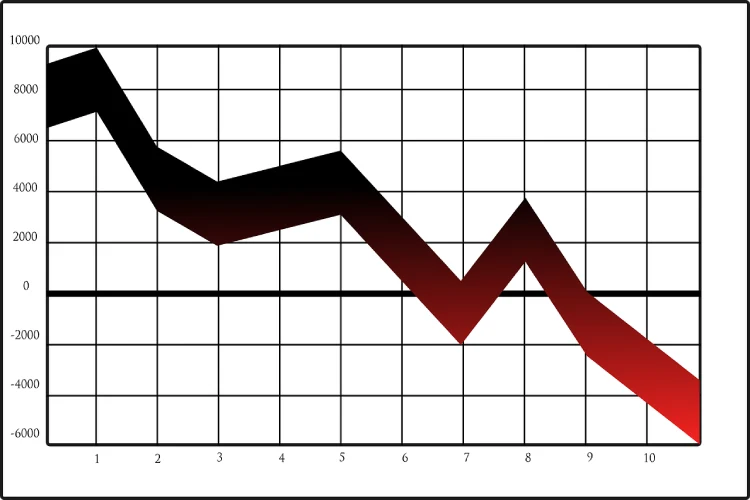What is a bear market? It’s like the stock market’s version of a stormy sea. Imagine a roller coaster, but instead of thrilling highs, you’re plummeting into a nerve-wracking downward spiral. A bear market officially kicks in when the stock market takes a nosedive of 20% or more from its peak, and this plunge lasts for a minimum of 60 heart-pounding days. Brace yourself; it’s not for the faint of heart.
Now, here’s the kicker: bear markets don’t just come and go in the blink of an eye. On average, they stick around for a little over a year, making you feel like you’re on an endless roller coaster ride. But hold onto your hats because recessions, those economic nightmares, are even longer, typically dragging on for about 17 agonizing months. The grand champion of bear markets lasted a jaw-dropping 630 days back in the tumultuous times of 1973 to 1974. It’s like enduring the longest, most nerve-wracking roller coaster ride of your life.
But here’s the twist: bear markets often play a little game of fortune-telling. They have this uncanny ability to predict a looming recession. You see, the reason why bear markets are shorter than recessions is because markets are like the Nostradamus of the financial world. They react quickly, almost like they can see the future, while recessions are only confirmed after the fact when the government releases those lagging GDP reports. It’s as if the stock market has a crystal ball, and it’s not afraid to use it.
Stage 1: The Market Shake-Up
The first phase we’re talking about here is like the calm before the storm. Picture this: stocks have been climbing higher and higher, setting record after record. It’s all sunshine and rainbows, but don’t get too comfortable.
Gradually, things start to change. The party slows down, and the once-thriving buy-the-dip strategy starts losing its mojo. Each time the market takes a little dip, the rebound isn’t as impressive as before. Fear of Missing Out (FOMO) takes center stage as people rush to buy when they see a glimmer of hope, only to watch it all crumble again.
Now, here’s where it gets intense. The strong buying momentum we used to see starts to dwindle. Every bounce on that dip goes a bit lower, and that’s when you know trouble is brewing. It’s like a rollercoaster that’s losing its thrill.
This is the start of a downward spiral, my friends. The market begins to drop consistently, making new lows, while those hopeful bounces can’t even reach the heights they used to. We’re talking about a proper downtrend here, where the market’s mood is getting darker by the day.
As the stocks keep tumbling, panic sets in like wildfire. The selling frenzy intensifies, and investors start biting their nails. You can’t turn on the evening news without seeing “Bear Market” headlines flashing, warning us of an impending financial doom. People start second-guessing their retirement plans as money pours out of investment funds.
Buyers, well, they decide to take a break. It’s like a strike in the stock market world. And, just when you thought it couldn’t get worse, it does. Multiple attempts to bounce back fail miserably, and we hit new lows faster than you can say “stock market crash.”
That’s when the real panic kicks in. We’re talking about sharp sell-offs that leave you breathless. Margin calls and forced liquidations make the situation even messier, causing huge gaps down in stock prices. It’s like a rollercoaster derailing.
When things are already bad, even the smallest hint of trouble sends stocks into a tailspin. The market is on a rollercoaster ride, but it’s one you wouldn’t wish on your worst enemy. Heavy, frantic selling reaches a peak, and everyone’s holding their breath. It’s like the moment before a storm hits, and you can feel the tension in the air. But where’s this rollercoaster headed?
Stage 2: The Epic Comeback
Picture this: The stock market takes a nosedive, hitting a new low. It’s like a rollercoaster ride that has taken a scary drop, and no one is quite sure if it’s going to crash and burn or somehow recover. After multiple failed attempts to bounce back, even the most die-hard optimists start to lose faith. They’re hesitant to dive back into the market, fearing another disappointment.
But then, something incredible happens. Against all odds, those feeble bounces start to stand their ground. It’s like watching a fighter who’s been knocked down repeatedly suddenly find their footing and refuse to go down again. The market, against all expectations, stabilizes.
And here’s where the magic really begins. The rebounds not only hold their ground but start gaining momentum. It’s as if a once-dying flame suddenly roars to life. Buyers, who were previously cautious, become more assertive. They swoop in to buy up the shares, and it’s like a battle between the bulls and the bears. Sell-offs happen, but they’re quickly soaked up by these fearless dip buyers.
As days go by, the stock market begrudgingly starts its ascent. It’s like a grumpy old man slowly but surely climbing a mountain. The optimism begins to build, and the bulls, who were on the brink of giving up, find their second wind. They’re back in the game, and they’re ready to do whatever it takes to ride the rally to the top. They’re even willing to pay a premium for a ticket on this steadily rising train, convinced that the worst is behind them.
With each wave of selling, it’s like building a new floor. It’s like saying, “You can’t bring us down that easily anymore!” This upward momentum motivates more and more buyers to jump in. They don’t want to miss out on the opportunity to be part of this remarkable recovery, this train to higher ground. It’s a comeback story that keeps everyone on the edge of their seats, eagerly anticipating what happens next.
Stage 3: The Ultimate Surrender and the Heart-Wrenching Plunge
In this final stage, the market puts on a show of bouncing up and down, like a yo-yo with a knack for playing tricks. It’s like a roller coaster with a mind of its own. People start feeling comfortable, maybe a little too much. They think the market has found its sweet spot in this lower range, but here’s the kicker: it’s a trap. Suddenly, the market takes a nosedive, smashing through those lows like a wrecking ball through a cardboard wall. Panic sets in faster than you can say “sell.” Bulls, who’ve been trying to catch the falling knife, finally throw in the towel. They’ve had enough of this wild ride.
Everyone is running for the exits, fearing that the floor beneath them is about to crumble. The media is having a field day, painting a doomsday picture that sends shivers down everyone’s spine. Investors are in a frenzy, selling everything in their portfolios as if they’re throwing out the baby with the bathwater.
Whole sectors take a hit as waves of panic selling sweep through like a hurricane tearing through a coastal town. New record lows are set, and it feels like the financial world is on the brink of collapse.
But here’s a twist – this time, those new lows seem to hold, at least for a while. The only folks still holding on are either playing the long game, not watching the chaos unfold, or they’ve reached a point where they just don’t care anymore. Their portfolios have taken such a beating that nothing seems to make a difference.
You see, the bottom is a tricky thing to spot in the heat of the moment. It’s only crystal clear when you look in that rearview mirror. If the market’s been tumbling for a while, it might make a U-shaped bottom, a slow and steady climb. But if the fall was sudden and sharp, like the 2020 pandemic crash, you might see a V-shaped rebound.
The silver lining in all this chaos? History tells us that every bear market has an expiration date. They don’t last forever, and guess what? They’re often followed by powerful bull markets. Now, keep in mind, we’re talking about the big boys in the benchmark indices, not every stock in the market. So, hold on to your hats, we’re in for a wild wild ride.

 Busting 4 Wealth Management Myths
Busting 4 Wealth Management Myths